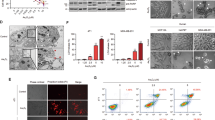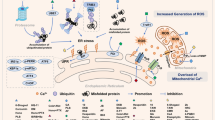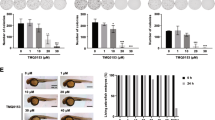Abstract
Cell death is generally believed to occur either by accidental, lytic necrosis or by programmed cell death, that is, apoptosis. The initiation and execution of cell death, however, is far more complex and includes pathways like caspase-independent apoptosis or actively triggered necrosis. In this study, we investigated the mechanisms of cell death induced by arsenic trioxide (arsenite, As2O3), a clinically efficient agent in anticancer therapy. As2O3-induced cell death coincides with cytochrome c release, facilitates mitochondrial permeability transition and is sensitive to inhibition by Bcl-xL, indicating that cell demise is regulated through the mitochondrial apoptosis pathway. Nevertheless, only little caspase-3 activation was observed and As2O3-induced cell death was only weakly obstructed by the broad spectrum caspase inhibitor z-VAD-fmk. Moreover, disruption of caspase-9 or -2 failed to decrease the amount of As2O3-mediated cell death. Interestingly, As2O3-induced cell death had a predominantly necrosis-like phenotype as assessed by Annexin-V/propidium iodide staining and LDH release. Finally, blocking glutathione synthetase by buthionine sulfoximine enhanced the As2O3-mediated necrosis-like cell death without increasing caspase-3 cleavage. As2O3 does, however, not directly inhibit caspases, but appears to interfere with caspase activation. Altogether, our data clearly delineate a mode of As2O3-triggered cell death that differs considerably from that induced by conventional anticancer drugs. These findings may explain the capability of As2O3 to efficiently kill even chemoresistant tumor cells with disturbed apoptosis signaling and caspase activation, a frequent finding in malignancy.
This is a preview of subscription content, access via your institution
Access options
Subscribe to this journal
Receive 50 print issues and online access
$259.00 per year
only $5.18 per issue
Buy this article
- Purchase on Springer Link
- Instant access to full article PDF
Prices may be subject to local taxes which are calculated during checkout






Similar content being viewed by others
References
Akao Y, Mizoguchi H, Kojima S, Naoe T, Ohishi N and Yagi K . (1998). Br. J. Haematol., 102, 1055–1060.
Belka C, Rudner J, Wesselborg S, Stepczynska A, Marini P, Lepple-Wienhues A, Faltin H, Bamberg M, Budach W and Schulze-Osthoff K . (2000). Oncogene, 19, 1181–1190.
Belka C, Schmid B, Marini P, Durand E, Rudner J, Faltin H, Bamberg M, Schulze-Osthoff K and Budach W . (2001). Oncogene, 20, 2190–2196.
Blagosklonny MV . (2000). Leukemia, 14, 1502–1508.
Bosanquet AG, Sturm I, Wieder T, Essmann F, Bosanquet MI, Head DJ, Dörken B and Daniel PT . (2002). Leukemia, 16, 1035–1044.
Chen YC, Lin-Shiau SY and Lin JK . (1998). J. Cell Physiol., 177, 324–333.
Dai J, Weinberg RS, Waxman S and Jing Y . (1999). Blood, 93, 268–277.
Daniel PT, Kroidl A, Kopp J, Sturm I, Moldenhauer G, Dörken B and Pezzutto A . (1998). Blood, 92, 4750–4757.
Daniel PT, Schulze-Osthoff K, Belka C and Güner D . (2003). Essays Biochem., 39, 73–88.
Daniel PT, Wieder T, Sturm I and Schulze-Osthoff K . (2001). Leukemia, 15, 1022–1032.
Dhein J, Daniel PT, Trauth BC, Oehm A, Moller P and Krammer PH . (1992). J. Immunol., 149, 3166–3173.
Engels IH, Stepczynska A, Stroh C, Lauber K, Berg C, Schwenzer R, Wajant H, Janicke RU, Porter AG, Belka C, Gregor M, Schulze-Osthoff K and Wesselborg S . (2000). Oncogene, 19, 4563–4573.
Fernandes RS and Cotter TG . (1994). Biochem. Pharmacol., 48, 675–681.
Fiers W, Beyaert R, Declercq W and Vandenabeele P . (1999). Oncogene, 18, 7719–7730.
Friedrich K, Wieder T, Von Haefen C, Radetzki S, Janicke R, Schulze-Osthoff K, Dörken B and Daniel PT . (2001). Oncogene, 20, 2749–2760.
Fulda S, Meyer E, Friesen C, Susin SA, Kroemer G and Debatin KM . (2001). Oncogene, 20, 1063–1075.
Gillissen B, Essmann F, Graupner V, Starck L, Radetzki S, Dörken B, Schulze-Osthoff K and Daniel PT . (2003). EMBO J., 22, 3580–3590.
Gottlieb E, Vander Heiden MG and Thompson CB . (2000). Mol. Cell Biol., 20, 5680–5689.
Güner D, Sturm I, Hemmati PG, Hermann S, Hauptmann S, Wurm R, Budach V, Dörken B, Lorenz M and Daniel PT . (2003). Int. J. Cancer, 103, 445–454.
Hasenjäger A, Gillissen B, Müller A, Normand G, Hemmati PG, Schuler M, Dörken B and Daniel PT . (2004). Oncogene, 23, 4523–4535.
Hemmati PG, Gillissen B, von Haefen C, Wendt J, Starck L, Güner D, Dörken B and Daniel PT . (2002). Oncogene, 21, 3149–3161.
Hu Y, Benedict MA, Ding L and Nunez G . (1999). EMBO J., 18, 3586–3595.
Jing Y, Dai J, Chalmers-Redman RM, Tatton WG and Waxman S . (1999). Blood, 94, 2102–2111.
Kitamura K, Minami Y, Yamamoto K, Akao Y, Kiyoi H, Saito H and Naoe T . (2000). Leukemia, 14, 1743–1750.
Kroemer G and Reed JC . (2000). Nat. Med., 6, 513–519.
Lanotte M, Martin-Thouvenin V, Najman S, Balerini P, Valensi F and Berger R . (1991). Blood, 77, 1080–1086.
Larochette N, Decaudin D, Jacotot E, Brenner C, Marzo I, Susin SA, Zamzami N, Xie Z, Reed J and Kroemer G . (1999). Exp. Cell Res., 249, 413–421.
Leist M and Jaattela M . (2001). Nat. Rev. Mol. Cell Biol., 2, 589–598.
Marsden VS, O'Connor L, O'Reilly LA, Silke J, Metcalf D, Ekert PG, Huang DC, Cecconi F, Kuida K, Tomaselli KJ, Roy S, Nicholson DW, Vaux DL, Bouillet P, Adams JM and Strasser A . (2002). Nature, 419, 634–637.
Mrozek A, Petrowsky H, Sturm I, Krauss J, Hermann S, Hauptmann S, Lorenz M and Daniel PT . (2003). Cell Death Differ., 10, 461–467.
Niu C, Yan H, Yu T, Sun HP, Liu JX, Li XS, Wu W, Zhang FQ, Chen Y, Zhou L, Li JM, Zeng XY, Yang RR, Yuan MM, Ren MY, Gu FY, Cao Q, Gu BW, Su XY, Chen GQ, Xiong SM, Zhang T, Waxman S, Wang ZY and Chen SJ . (1999). Blood, 94, 3315–3324.
Norbury CJ and Zhivotovsky B . (2004). Oncogene, 23, 2797–2808.
Perkins C, Kim CN, Fang G and Bhalla KN . (2000). Blood, 95, 1014–1022.
Peter ME and Krammer PH . (2003). Cell Death Differ., 10, 26–35.
Prokop A, Wieder T, Sturm I, Essmann F, Seeger K, Wuchter C, Ludwig W-D, Henze G, Dörken B and Daniel PT . (2000). Leukemia, 14, 1606–1613.
Prokop A, Wrasidlo W, Lode H, Herold R, Lang F, Henze G, Dörken B, Wieder T and Daniel PT . (2003). Oncogene, 22, 9107–9120.
Radetzki S, Kohne CH, von Haefen C, Gillissen B, Sturm I, Dörken B and Daniel PT . (2002). Oncogene, 21, 227–238.
Reers M, Smiley ST, Mottola-Hartshorn C, Chen A, Lin M and Chen LB . (1995). Methods Enzymol., 260, 406–417.
Robertson JD, Gogvadze V, Kropotov A, Vakifahmetoglu H, Zhivotovsky B and Orrenius S . (2004). EMBO Rep., 5, 643–648.
Rudner J, Lepple-Wienhues A, Budach W, Berschauer J, Friedrich B, Wesselborg S, Schulze-Osthoff K and Belka C . (2001). J. Cell Sci., 114, 4161–4172.
Saleh A, Srinivasula SM, Acharya S, Fishel R and Alnemri ES . (1999). J. Biol. Chem., 274, 17941–17945.
Schelwies K, Sturm I, Grabowski P, Scherubl H, Schindler I, Hermann S, Stein H, Buhr HJ, Riecken EO, Zeitz M, Dörken B and Daniel PT . (2002). Int. J. Cancer, 99, 589–596.
Schmelz K, Wieder T, Tamm I, Müller A, Essmann F, Geilen CC, Schulze-Osthoff K, Dörken B and Daniel PT . (2004). Oncogene, 23, 6743–6759.
Shen ZX, Chen GQ, Ni JH, Li XS, Xiong SM, Qiu QY, Zhu J, Tang W, Sun GL, Yang KQ, Chen Y, Zhou L, Fang ZW, Wang YT, Ma J, Zhang P, Zhang TD, Chen SJ, Chen Z and Wang ZY . (1997). Blood, 89, 3354–3360.
Soignet SL, Maslak P, Wang ZG, Jhanwar S, Calleja E, Dardashti LJ, Corso D, DeBlasio A, Gabrilove J, Scheinberg DA, Pandolfi PP and Warrell Jr RP . (1998). N. Engl. J. Med., 339, 1341–1348.
Sturm I, Petrowsky H, Volz R, Lorenz M, Radetzki S, Hillebrand T, Wolff G, Hauptmann S, Dörken B and Daniel PT . (2001). J. Clin. Oncol., 19, 2272–2281.
Troy CM and Shelanski ML . (2003). Cell Death Differ., 10, 101–107.
van Loo G, Saelens X, van Gurp M, MacFarlane M, Martin SJ and Vandenabeele P . (2002). Cell Death Differ., 9, 1031–1042.
Vander Heiden MG, Chandel NS, Li XX, Schumacker PT, Colombini M and Thompson CB . (2000). Proc. Natl. Acad. Sci. USA, 97, 4666–4671.
Vermes I, Haanen C, Steffens-Nakken H and Reutelingsperger C . (1995). J. Immunol. Methods, 184, 39–51.
von Haefen C, Wieder T, Essmann F, Schulze-Osthoff K, Dörken B and Daniel PT . (2003). Oncogene, 22, 2236–2247.
von Haefen C, Wieder T, Gillissen B, Starck L, Graupner V, Dörken B and Daniel PT . (2002). Oncogene, 21, 4009–4019.
Wang TS, Kuo CF, Jan KY and Huang H . (1996). J. Cell Physiol., 169, 256–268.
Wang ZG, Rivi R, Delva L, Konig A, Scheinberg DA, Gambacorti-Passerini C, Gabrilove JL, Warrell Jr RP and Pandolfi PP . (1998). Blood, 92, 1497–1504.
Wieder T, Essmann F, Prokop A, Schmelz K, Schulze-Osthoff K, Beyaert R, Dörken B and Daniel PT . (2001). Blood, 97, 1378–1387.
Wyllie AH, Kerr JF and Currie AR . (1980). Int. Rev. Cytol., 68, 251–306.
Yang CH, Kuo ML, Chen JC and Chen YC . (1999). Br. J. Cancer, 81, 796–799.
Zhang W, Ohnishi K, Shigeno K, Fujisawa S, Naito K, Nakamura S, Takeshita K, Takeshita A and Ohno R . (1998). Leukemia, 12, 1383–1391.
Zhu J, Koken MH, Quignon F, Chelbi-Alix MK, Degos L, Wang ZY, Chen Z and de The H . (1997). Proc. Natl. Acad. Sci. USA, 94, 3978–3983.
Zhu XH, Shen YL, Jing YK, Cai X, Jia PM, Huang Y, Tang W, Shi GY, Sun YP, Dai J, Wang ZY, Chen SJ, Zhang TD, Waxman S, Chen Z and Chen GQ . (1999). J. Natl. Cancer Inst., 91, 772–778.
Zong WX, Ditsworth D, Bauer DE, Wang ZQ and Thompson CB . (2004). Genes Dev., 18, 1272–1282.
Zou H, Li Y, Liu X and Wang X . (1999). J. Biol. Chem., 274, 11549–11556.
Acknowledgements
We would like to thank A Richter for expert technical assistance. NB4 cells were kindly provided by Dr H Drexler, DSMZ, Braunschweig, Germany, BJAB-Bcl-xL and mock transfectants by Dr S Fulda, University of Ulm, Germany and caspase-2 or -9 knockout fibroblasts by Dr A Strasser, WEHI Institute, Melbourne, Australia. This work was supported by the Deutsche Krebshilfe and the Deutsche José Carreras Leukämie-Stiftung.
Author information
Authors and Affiliations
Corresponding author
Rights and permissions
About this article
Cite this article
Scholz, C., Wieder, T., Stärck, L. et al. Arsenic trioxide triggers a regulated form of caspase-independent necrotic cell death via the mitochondrial death pathway. Oncogene 24, 1904–1913 (2005). https://doi.org/10.1038/sj.onc.1208233
Received:
Revised:
Accepted:
Published:
Issue Date:
DOI: https://doi.org/10.1038/sj.onc.1208233
Keywords
This article is cited by
-
Effect of lycopene on As2O3 induced oxidative stress in SH-SY5Y cells
Molecular Biology Reports (2021)
-
Antitumor activity of arsenite in combination with tetrandrine against human breast cancer cell line MDA-MB-231 in vitro and in vivo
Cancer Cell International (2018)
-
Pan-class I PI3-kinase inhibitor BKM120 induces MEK1/2-dependent mitotic catastrophe in non-Hodgkin lymphoma leading to apoptosis or polyploidy determined by Bax/Bak and p53
Cell Death & Disease (2018)
-
Arsenic Induces Thioredoxin 1 and Apoptosis in Human Liver HHL-5 Cells
Biological Trace Element Research (2018)
-
Cytokine-induced senescence for cancer surveillance
Cancer and Metastasis Reviews (2017)



